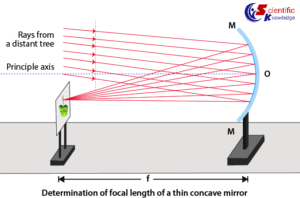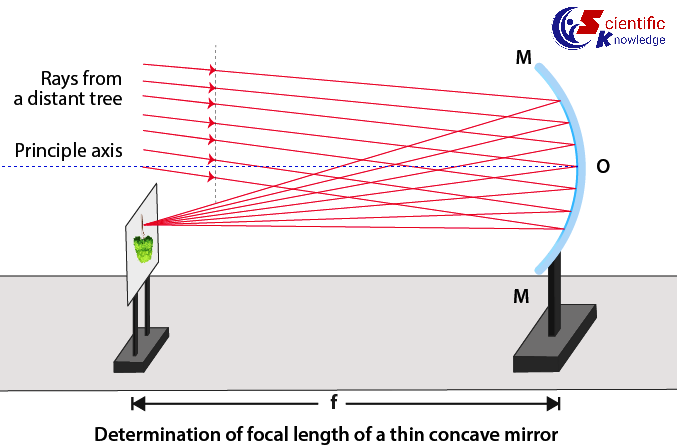Experiment : 07
Aim
To determine the focal length of: Concave mirror and Convex lens by obtaining the image of a distant object.
Theory
Following are the ways to obtain the focal length of the concave mirror:
- A concave mirror is defined as the spherical mirror whose reflecting surface is curved inwards and follows laws of reflection of light.
- The light rays coming from a distant object can be considered to be parallel to each other.
- If the image formed is real, inverted and very small in size, then the parallel rays of light meet the point in the front of the mirror.
- The image formed by the convex lens is real and can be obtained on the screen.
- f is used to denote the difference between the principal axis P and the focus F of the concave mirror.
Following are the ways to obtain the focal length of convex lens:
- The convex lens is thicker in the middle and thinner at the edges and is also known as the converging lens.
- The refracted rays from the parallel beam of light converge on the other side of the convex lens.
- If the image is obtained at the focus of the lens, the image would be real, inverted and very small.
- f is the focal length which is the difference between the optical centre of the lens and the principal focus.
- The image can be obtained on the screen as the image formed by the lens is real.
To determine focal length of a given concave mirror
Materials Required
- A concave mirror
- A measuring scale
- A screen holder
- A mirror holder
- A mirror stand
Procedure
- The distance between the selected distinct object should be more than 50 ft.
- The concave mirror placed on the mirror stand and the distant object should be facing each other.
- The screen should be placed in front of the reflecting surface of the mirror. To obtain a clear, sharp image the screen should be adjusted.
- Using a metre scale the distance between the concave mirror and screen can be determined. The distance is the same as the focal length of the given concave mirror.
- Repeat the above procedure thrice to calculate the average focal length.
Experimental Setup

Observation Table
| S.N. | Position of concave mirror (M) | Position of screen (S) | Focal length = (M-S)cm |
| 1 | 60 cm | 50 cm | 10 cm |
| 2 | 60 cm | 50 cm | 10 cm |
| 3 | 60 cm | 50 cm | 10 cm |
Calculation
Following is the mean value of the focal length of concave mirror:
(f1+f2+f3)/3 cm =10 cm
Result
10 cm is the focal length of the concave mirror.
Precautions
- To get a well illuminated and distinct image of the distinct object, the distant object should be well illuminated.
- A concave mirror should be always placednear an open window.
- The polished surface of the concave mirror and the distinct object should be facing each other.
- There should not be any hurdle between the rays of light from the object and the concave mirror.
- The screen and the concave mirror stand should be parallel to the measuring scale.
- The mirror holder along with the mirror should be perpendicular to the measuring scale.
To determine focal length of a convex lens
Materials Required
- A wooden bench
- A convex lens
- A lens holder
- A screen fixed to a stand
- A measuring scale
Experimental Setup

Procedure
- Without disturbing the lens and screen, arrange both of them on the wooden bench.
- Place the lens on the holder facing a distant object.
- Place the holder with the screen on the bench.
- The position of the screen should be such that the sharp image of the distant object is obtained on it.
- The difference between the position of the lens and the screen is equal to the focal length of the given convex lens.
- Now shift the focus to towards various other distant object and calculate the focal length of the convex lens.
Observation Table
| Sl.no | Position of convex lens (L) | Position of screen (S) | Focal length = (L-S) cm |
| 1 | 60 cm | 50 cm | f1 = 10cm |
| 2 | 60 cm | 50 cm | f2 = 10cm |
| 3 | 60 cm | 50 cm | f3 = 10cm |
Calculation
Following is the mean value of the focal length of convex lens:
(f1+f2+f3)/3 cm =10 cm
Result
10 cm is the focal length of the concave mirror.
Precautions
- The placing of the convex lens should be vertical.
- There should not be any hurdle between the rays of light from the object and the convex lens.
- To get a well illuminated and distinct image of the distinct object, the distant object should be well illuminated.
- The convex lens stand and the screen should be parallel to the measuring scale.
List of Experiments :
Experiment -01 To determine the pH of the given samples using pH paper or universal indicator. The samples whose pH has to be determined are-
Experiment -02: How can you explain plants can respire and release carbon dioxide?
Experiment -03 To study about (a) Binary Fission in amoeba and (b) Budding in yeast with the help of prepared slides.
Experiment – 05 Types of Reactions
Experiment – 06 : Observing the action of zinc, iron, copper and aluminium metals for the given salt solutions.
Experiment – 07 : Obtaining the focal length of Concave mirror and Convex lens.





More Stories
Full Revision रासायनिक अभिक्रियाएँ एवं समीकरण
अंबेडकर नगर बौद्धिक पत्रक मार्च-अप्रैल 2023
10 Important Exam Tips